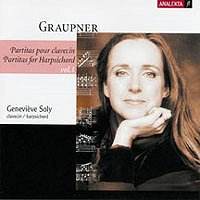Christophe Graupner was a modest man who brushed
often with greatness. A contemporary of Bach and Handel, he for
a time played in the opera orchestra at Hamburg with the latter.
His refusal to accept the position of Kantor at the Leipzig
Thomaskirche paved the way for J. S. Bach to accept the
position in his place, and with his hearty recommendation. Fasch
and Heinichen were numbered amongst his friends and he had an
esteemed reputation in the German musical life of his day. He
composed over two thousand works, more than forty for solo harpsichord.
He left little organ music behind, as the organ was his preferred
medium for improvisation and he rarely committed his organ music
to paper. Meticulous in his musical manuscript, his hand was such
that many thought the works before them had been engraved. Ironically,
his overt modesty led him to instruct in his will that all of
his music be destroyed upon his death. Thanks to the persistence
of the Darmstadt court, which Graupner served for more than forty
years, his music has survived and is now in the possession of
the library at the university in that city.
Of the forty-one partitas that Graupner composed
for harpsichord (he wrote very few solo keyboard works in any
genre other than the partita) fewer than a dozen have survived
in published editions. Heavily influenced by his French colleagues,
there is little about this music that can be termed German. There
is a predilection, however, toward the use of a more Italianate
style in the Airs.
Upon hearing this recording, I am inclined to
believe that this music is more fun to play than it is to listen
to. Not that there is anything particularly bad about it, mind,
but just how riveting can long sets of dance movements be anyway?
Perhaps that is making light of a talented composerís efforts,
and there is certainly interesting counterpoint, and one mighty
chaconne in the A major partita that truly shines. What
I continued to imagine as I listened, is that I was hearing music
that I know I would enjoy sitting down with and learning to play.
I would perhaps even enjoy it as background music to accompany
the reading of a good book, or the filing of an income tax return.
But in a recital, it would likely facilitate a popcorn purchase.
Regardless of the somewhat uninteresting music,
Ms. Soly is a player of enormous gifts, with the perfect combination
of technical skill and musicality. She is an elegant player, and
brings out the French mannerisms in these scores without making
them tiresome or fussy as authentically French keyboard music
of the period often tends to be. Her instrument is a fine one,
built by Hubbard and Brockman in 1998 and modeled after German
instruments of the 1730s. It has a beautiful luster to its sound,
and the variety of colors and registrations that Ms. Soly achieves
is remarkable and commendable.
Analekta know how to produce a recording. The
sound quality is superb, the booklet notes by Hendrik Broekmann
are outstanding and the reprints of musical excerpts and other
historical documents lend further grace to an already fascinating
overall production. It is this artistís intent to record all forty-one
of Graupnerís partitas. One must wonder however if the classical
music industryís obsession with completeness is not a bit counter
productive. I for one am not too sure that I need forty-one of
these pieces in my library. A good dozen will suffice.
A must for collectors and fans of unusual harpsichord
works; a one-off for those with a passing interest in North German
baroque keyboard music.
Kevin Sutton

